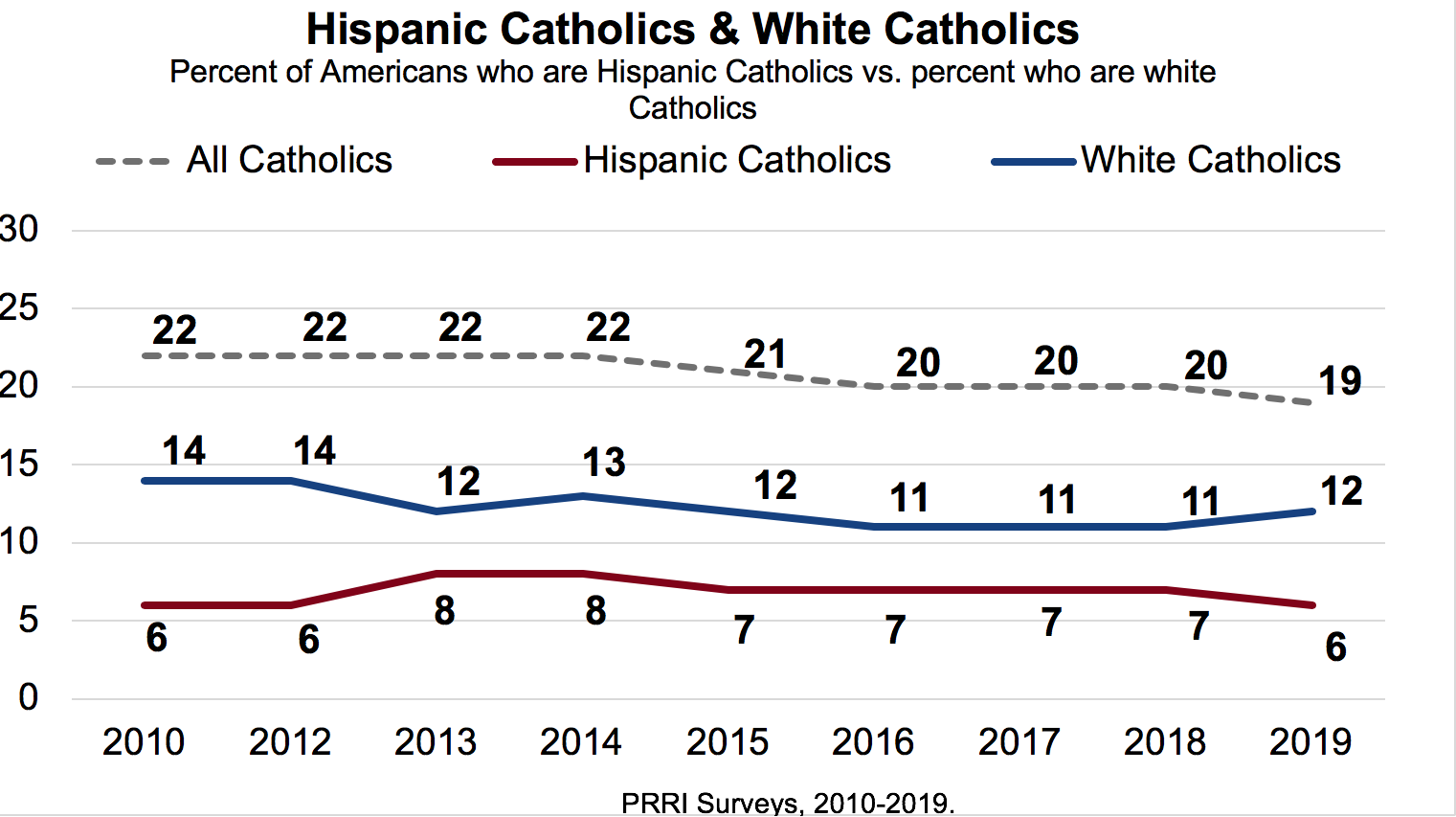The U.S. Catholic Experience
In the past decade, the Catholic church in the United States has experienced shifts from a largely white church to a church influenced by Latin American immigration. About one in five Americans (19%) identify as Catholic according to the PRRI 2019 American Values Survey, down slightly from 22% in 2010. This change is mostly driven by a slight decrease among white Catholics from 14% to 12%, while the proportion of Hispanic Catholics has remained fairly stable over time (6%).

Hispanic and white Catholics do not differ in most of their opinions regarding issues they identify as critical. The top three issues Hispanic Catholics identify as critical are health care (73%), terrorism (63%), and climate change (62%), while the top three issues for white Catholics are terrorism (63%), health care (63%), and immigration (57%). However, Hispanic Catholics are notably more likely than white Catholics to say climate change (62% vs. 41%), race relations (56% vs. 38%), and the growing gap between rich and poor (46% vs. 31%) are critical issues.
Demographics
Hispanic Catholics are much more likely to identify as Democrats than white Catholics. Specifically, 52% of Hispanic Catholics are Democrat, 32% independent, and 14% Republican, while 26% of white Catholics are Democrats, 40% independent, and 30% Republican.
Hispanic Catholics tend to be younger than white Catholics. Most Hispanic Catholics (68%) are under 50 years old, while about one-third (32%) are over 50. By contrast, a majority of white Catholics are over 50 years old (60%), while four in ten (40%) are under 50.
There is also a noticeable educational gap. A slim majority of Hispanic Catholics report having high school or less education (51%), about one-third (32%) some college, and nearly one in five (18%) a college education. By contrast, less than four in ten white Catholics (37%) say they hold a high school or less education, about one in four (24%) some college, and nearly four in ten (39%) a college education.
Hispanic Catholics tend to live more in the West and in the South. About four in ten (41%) Hispanic Catholics live in the West, nearly four in ten (38%) live in the South, about one in five (17%) live in the Northeast, and less than one in ten (4%) live in the Midwest. By contrast, white Catholics live mostly in the Northeast (39%), nearly three in ten (28%) live in the Midwest, one in four (25%) live in the South, and nearly one in ten (8%) live in the West.
Finally, Hispanic Catholics are less likely to attend religious services frequently than white Catholics. Nearly one in five (19%) Hispanic Catholics attend religious services at least once a week or more, nearly half (46%) attend once or twice a month or a few times a year, and one-third (33%) of Hispanic Catholics attend seldom or never. By contrast, nearly four in ten (38%) white Catholics attend religious services at least once a week or more, a little over one-third (35%) of white Catholics attend once or twice a month or a few times a year, and nearly three in ten (27%) attend seldom or never.
Climate Change
Hispanic Catholics are particularly concerned with issues related to climate change. Nearly two-thirds of Hispanic Catholics (66%) and a slim majority of white Catholics (53%) say there is climate change and it is caused mostly by human activity such as burning fossil fuels. About one in five Hispanics (21%) and white Catholics (24%) also believe there is climate change, but that it is mostly caused by natural patterns in the earth’s environment. By contrast, about one in ten Hispanic Catholics (12%) and about one in five white Catholics (21%) believe there is no climate change. Hispanic Catholics are particularly more likely than white Catholics to think that climate change will cause a great deal or a moderate amount of harm to them personally (76% vs. 47%).
Race Relations
Hispanic and white Catholics differ in their views regarding race. Hispanic Catholics are less than half as likely as white Catholics to completely or mostly agree with the idea that “today discrimination against whites has become as a big a problem as discrimination against blacks and other minorities” (26% vs. 59%). When Hispanic and white Catholics were asked in 2018 if there is a lot of discrimination against black Americans, whites, Asians, and Hispanics, they did not differ significantly in their opinions regarding discrimination against black Americans and Asians. Hispanic and white Catholics are about twice as likely to think there is a lot of discrimination against black Americans (75% and 67%, respectively) as there is a lot of discrimination against Asians (36% for both). However, Hispanic Catholics are notably more likely than white Catholics to say that there is a lot of discrimination against Hispanics (76% vs. 59%), while white Catholics are notably more likely than Hispanic Catholics to say there is a lot of discrimination against whites (45% vs. 11%).[1] When Hispanic Catholics were asked about their views in 2018 on the impact of demographic changes in the future as the U.S. Census projections show that by 2045, black Americans, Latinos, Asians, and other mixed racial and ethnic groups will together be a majority of the population, an overwhelming majority of Hispanic Catholics said that the impact will be mostly positive (81%), compared to a slim majority of white Catholics (51%) who expressed the same view.[2]
Growing Gap Between Rich and Poor
Hispanic Catholics are also concerned with the growing gap between the rich and the poor. When thinking about capitalism as an economic system, Hispanic Catholics (54%) are more likely than white Catholics (37%) to describe capitalism as a system where the interests of businesses and company shareholders are placed above the interests of workers and the middle class. By contrast, when thinking about socialism, Hispanic Catholics (64%) are more likely than white Catholics (44%) to describe socialism as a system in which the government provides citizens with health insurance, retirement support, and access to free higher education. Concerns about the growing gap between the rich and the poor among Hispanic Catholics is perhaps due to their economic anxieties. Hispanic Catholics (28%) are nearly twice as likely as white Catholics (16%) to say that in the case of having an emergency expense that costs $400, it will be very difficult or nearly impossible to pay for this expense.
[1] PRRI 2018 American Values Survey
[2] PRRI 2018 American Values Survey




